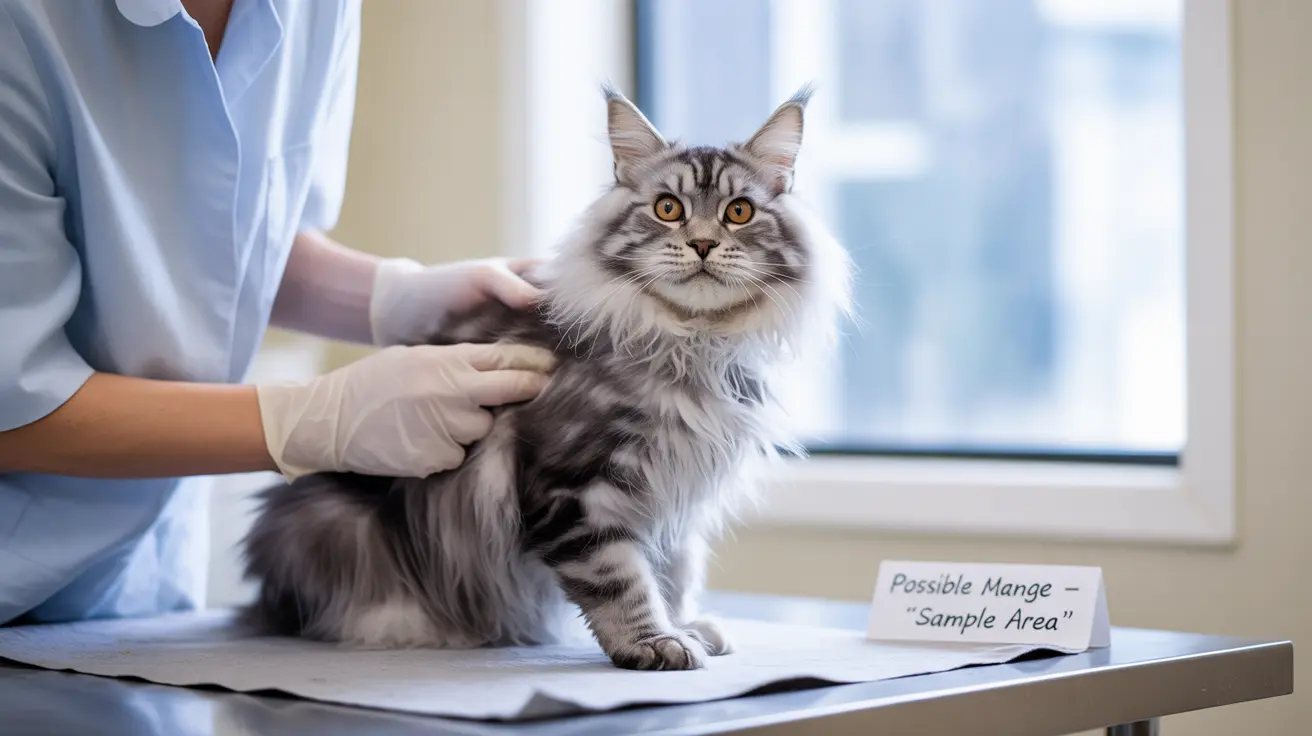When it comes to feline health concerns, mange in cats often goes underrecognized despite its significant impact on our furry companions. This parasitic skin condition, caused by microscopic mites, can lead to severe discomfort and health complications if left untreated. While less common than in dogs, cat mange requires immediate attention and proper veterinary care to ensure successful treatment.
As a responsible cat owner, understanding the various types of mange, their symptoms, and available treatments is crucial for maintaining your pet's health. This comprehensive guide will walk you through everything you need to know about managing and preventing mange in your feline friend, from initial diagnosis to long-term prevention strategies.
Types of Mange Affecting Cats
Demodectic Mange
Demodectic mange is caused by Demodex cati and Demodex gatoi mites, which reside within a cat's hair follicles or on the skin surface. While these mites are generally present in small, harmless numbers, cats with weakened immune systems are susceptible to infestations that can lead to significant skin problems. This type of mange is especially common among kittens, elderly cats, or those with underlying illnesses, as their bodies are less able to control the mite population. In addition to addressing the infestation, it is important for owners and veterinarians to consider the cat's overall health, as effective immune support can play a vital role in reducing symptoms and preventing recurrence.
Notoedric Mange (Feline Scabies)
Notoedric mange, also known as feline scabies, is one of the most contagious forms of mange. Caused by the Notoedres cati mite, it spreads rapidly through direct contact with infected animals or contaminated objects such as bedding and grooming tools. Affected cats typically develop intense itching, visible skin crusts, and hair loss, especially around the ears, head, and neck. Since Notoedric mange can occasionally be transmitted to humans and other animals, prompt diagnosis and isolation of affected pets is crucial to prevent outbreaks and further spread within multi-pet households.
Cheyletiellosis (Walking Dandruff)
Cheyletiellosis, commonly referred to as walking dandruff, presents unique challenges for both diagnosis and management. The larger size of Cheyletiella mites makes them more visible, sometimes appearing as moving flakes of dandruff on the cat's skin. This condition is highly contagious, not only to other cats but also potentially to dogs and humans. Owners may notice increased itching and observing fleas moving alongside flakes of dead skin. Treatment involves not just addressing the mites on the cat, but also thoroughly cleaning and treating the home environment to eradicate mites from carpets, furniture, and pet bedding to prevent reinfestation.
Identifying Cat Mange Symptoms
Early recognition of mange symptoms is essential for effective treatment and improved prognosis. Cat owners should be vigilant and look for the following key signs that may indicate the presence of mange:
- Intense scratching and persistent skin itching that does not resolve with grooming
- Noticeable patches of cat hair loss, especially in areas that are red or irritated
- Development of skin lesions, such as sores, bumps, or open wounds
- Crusty or scaly skin, which may be accompanied by inflamed or thickened areas
- Excessive grooming or self-biting in response to severe itchiness
- Visible dandruff-like particles that seem to move, indicating the presence of mites under the skin
These symptoms can quickly worsen if left untreated, leading to secondary bacterial or fungal infections. It is essential to consult a veterinarian as soon as any of these warning signs appear to ensure a timely and accurate diagnosis.
Diagnosis and Treatment Approaches
Professional Diagnosis
Diagnosing mange in cats requires a visit to the veterinarian, as home assessments may miss subtle signs or confuse mange with other skin conditions. The diagnostic process typically includes:
- A thorough physical and skin examination, focusing on common sites of mange-related irritation
- Microscopic analysis of skin scrapings to detect and identify the specific type of mite responsible
- A review of the cat's symptoms and full medical history to rule out other causes
- Differential diagnoses to exclude other common cat skin diseases such as allergies, fungal infections, or bacterial dermatitis
This comprehensive approach ensures that the correct type of mange is identified, allowing for targeted and effective treatment.
Treatment Options
Treating mange in cats involves a combination of medical and environmental interventions tailored to the specific mite and severity of the infestation. Common treatment protocols include:
- Prescription antiparasitic medications, often administered orally, topically, or via injections, which are designed to kill the mites
- Medicated baths or dips that help to reduce the mite population on the skin and provide relief from irritation
- Treatment for secondary infections, such as antibiotics or antifungals, if the skin has become damaged or infected
- Environmental decontamination, including thorough cleaning and disinfecting of toys, bedding, grooming tools, and living spaces
- Regular follow-up examinations to assess progress, monitor for side effects, and prevent recurrence by adjusting treatment as needed
In some cases, supportive therapies like immune-boosting supplements or dietary changes may be recommended to promote healing and reduce recurrence risk.
Prevention and Long-term Management
Preventing mange and successfully managing recovery require ongoing vigilance and good pet care habits. Effective prevention and long-term strategies include:
- Scheduling regular veterinary check-ups to catch and address issues early
- Providing proper nutrition tailored to support immune health and skin integrity
- Preventing direct contact with infected animals by supervising interactions and avoiding high-risk environments
- Routinely cleaning and sanitizing bedding, grooming tools, and living areas to reduce environmental mite loads
- Treating any risk factors or early symptoms quickly to minimize spread and severity
Implementing these proactive steps greatly reduces the chances of recurrence and supports your cat's health over the long term.
Frequently Asked Questions
- What is mange in cats? Mange in cats is a skin disease caused by parasitic mites leading to itching, hair loss, and potential skin damage. If left unmanaged, the disease can become progressively more severe.
- What are the main types of mange in cats? The primary types are Notoedric mange, Demodectic mange, and Cheyletiellosis, each involving different species of mites and requiring varying treatment approaches.
- What causes mange in cats? Mange is caused by infestation with mites such as Notoedres cati, Demodex species, or Cheyletiella blakei, which burrow into or crawl on the skin.
- How can I recognize mange symptoms in my cat? Watch for persistent itching, hair loss, skin redness, crusty lesions, and unusual dandruff. Behavior changes like increased grooming or irritability may also occur.
- Is mange in cats contagious to humans or other animals? Some forms, such as sarcoptic (Notoedric) mange and Cheyletiellosis, are contagious to other pets, and occasionally humans, so prompt isolation and treatment are vital.
- How is mange diagnosed in cats? Diagnosis is performed by a veterinarian through skin scrapings, microscopic mite identification, and ruling out other skin diseases.
- What treatments are available for mange in cats? Treatment includes medicated baths, antiparasitic drugs (topical, oral, or injectable), addressing secondary infections, and thorough environmental cleaning.
- How long does it take for a cat to recover from mange? Recovery time varies by severity and type, but most cats show improvement within a few weeks of starting comprehensive treatment.
- Can mange be prevented in cats? Yes, prevention includes regular grooming, parasite control measures, prompt treatment of infestations, and minimizing contact with infected animals and contaminated environments.
- What should I do if I suspect my cat has mange? If you notice signs of mange, consult a veterinarian as soon as possible to ensure an accurate diagnosis and begin effective treatment, helping your cat return to health quickly.
Understanding and properly treating mange in cats is essential for ensuring your pet's health and comfort. While mange home remedies might seem tempting, professional veterinary care provides the most effective and safest path to recovery. With appropriate treatment and diligent preventive measures, cats can fully recover from mange and happily return to their regular routines, free of discomfort and risk of recurrence.






